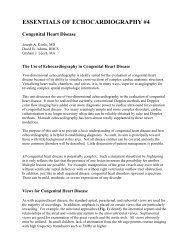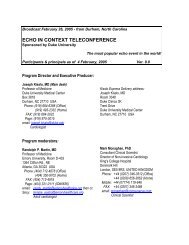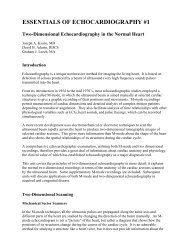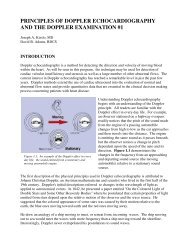doppler evaluation of valvular stenosis #3 - Echo in Context
doppler evaluation of valvular stenosis #3 - Echo in Context
doppler evaluation of valvular stenosis #3 - Echo in Context
Create successful ePaper yourself
Turn your PDF publications into a flip-book with our unique Google optimized e-Paper software.
formula generally overestimate severity when<br />
compared with catheterization peak-to-peak<br />
gradients. Accord<strong>in</strong>gly, Doppler estimates <strong>of</strong><br />
severity would be expected to correlate best<br />
with the peak gradient at catheterization.<br />
Figure 3. 29 Idealized relationship between Doppler<br />
peak gradient and catheterization peak-to-peak<br />
gradient. Comparisons show that there is<br />
overestimation <strong>of</strong> catheterization peak-to-peak<br />
gradient.<br />
In an attempt to evaluate the use <strong>of</strong> Doppler<br />
echocardiography <strong>in</strong> cl<strong>in</strong>ical practice, we<br />
studied sixty consecutive patients who were<br />
referred to the catheterization laboratory with<br />
cl<strong>in</strong>ical f<strong>in</strong>d<strong>in</strong>gs suggestive <strong>of</strong> possible aortic<br />
<strong>stenosis</strong> (aortic systolic murmur and peripheral<br />
pulse deficit). All patients underwent cardiac<br />
catheterization at a time remote from the<br />
Doppler study (usually after 24 hours). The<br />
Doppler exam<strong>in</strong>ation and <strong>in</strong>terpretation was<br />
performed without knowledge <strong>of</strong> the results <strong>of</strong><br />
catheterization. Our patients were older than<br />
many <strong>of</strong> the groups reported from other centers<br />
(mean age 63 years), as one might anticipate <strong>in</strong><br />
rout<strong>in</strong>e cl<strong>in</strong>ical practice, and 45% had a 2+ or<br />
greater aortic <strong>in</strong>sufficiency.<br />
As can be seen <strong>in</strong> Figure 3.29, Doppler over-estimation <strong>of</strong> catheterization peak-to-peak gradient <strong>in</strong><br />
our series was sometimes quite significant. Indeed, overestimations are evident over the entire<br />
spectrum <strong>of</strong> gradient values and vary <strong>in</strong> magnitude between 1 and 53mmHg. In our view, this<br />
f<strong>in</strong>d<strong>in</strong>g suggests that the cl<strong>in</strong>ician must be very careful <strong>in</strong> us<strong>in</strong>g catheterization laboratory criteria<br />
for estimat<strong>in</strong>g the severity <strong>of</strong> an aortic gradient with Doppler peak aortic gradient valves.<br />
Doppler and catheterization estimates are more<br />
comparable when both laboratories report the<br />
peak aortic valve gradient (Fig. 3.30). The<br />
scatter <strong>of</strong> our data is obviously great because<br />
the studies were not performed simultaneously<br />
with catheterization. Altered hemodynamic<br />
states with different volumes <strong>of</strong> blood flow<br />
across the aortic valve could easily account for<br />
the differences between catheterization and<br />
Doppler gradients <strong>in</strong> nonsimultaneous studies.<br />
When Doppler data are collected<br />
simultaneously with catheterization, us<strong>in</strong>g<br />
micromanometer-tipped catheters, the<br />
correlations are much better.<br />
In rout<strong>in</strong>e cl<strong>in</strong>ical practice, Doppler estimates <strong>of</strong><br />
the severity <strong>of</strong> aortic <strong>stenosis</strong> are likely to be made at least 24 hours before catheterization. These<br />
Figure 3. 30 Idealized relationship between Doppler<br />
peak gradient and catheterization peak gradient. S<strong>in</strong>ce<br />
Doppler reflects peak catheterization gradient, the<br />
comparisons are more favorable.<br />
Doppler measurements may f<strong>in</strong>d a role <strong>in</strong><br />
select<strong>in</strong>g patients for <strong>in</strong>vasive study.<br />
Eventually, they may be used to refer some<br />
patients to surgery without prior catheterization.








